I would never, ever claim to be any sort of parenting expert… or even knowledgeable to give any sort of real “parenting advice”. In fact, I’m often the one looking for answers, asking the questions, reading books, and wondering “How did I not know this before?” or “Why didn’t I think of that?”
I think my motherhood journey could most accurately be summed up with the following statement:
Lots and lots of trial and error, marginal success, and a whole bunch of sticktoitiveness!
(they couldn’t figure out how I realized they snuck a Hershey’s Kiss!)
I realize I will never be the perfect mom and my kids will never be perfect children… but there is one thing that bugs me almost more than anything else (even more than noisy chewing — and that’s really saying something for me).
I can NOT stand it when I have to ask my kids to do something multiple times before they actually do it.
“Please pick up the dressup clothes and change back into your regular clothes for lunch.”
5 minutes later, they’re still happily playing.
“Get those dressup clothes put away. Your lunch is almost ready and you need to change into your regular clothes.”
No response.
“Your lunch is ready… are the dressup clothes picked up?”
Oh yay, lunch time! they shout as they run down the stairs (still in their dressup clothes) to eat lunch.
“After you go to the bathroom, I want you to get dressed, brush your hair, and make sure your folder is in your backpack.”
She scampers off to the bathroom.
“Nora, did you get dressed yet?”
“no”… as she runs to her bedroom.
“Nora, did you brush your hair yet?”
“not yet”… as she runs to the bathroom.
“Nora, did you get your backpack ready yet?
“I thought you did that”… as she heads to the mudroom to get her backpack.
Oh. My. Word… It drives me crazy!
Most of the time, I truly don’t think they are blatantly disobeying me as much as they literally just don’t pay attention to anything I say, or forget what I said the moment after I said it.
So, I started making them repeat what I said after I said it.
The very first time I did this with Nora, the conversation went something like this:
ME: After you finish your snack, I want you to pick up all the play food.
NORA: Thanks for my snack.
ME: And what are you going to do after you finish your snack?
NORA: (staring blankly) Get a drink? Go to the bathroom?
ME: No, what did I just ask you to do after your snack?
NORA: I don’t know? Did you ask me to do something?
ME: Yes. I asked you to pick up all the play food after you finished your snack… OK?
NORA: Fine.
ME: So what do you need to do after your snack?
NORA: Pick up the play food?
ME: Exactly.
And… she actually did it relatively quickly too!
.
Now I don’t want any of you to get the impression that by simply asking my kids to repeat what I say magically compels them to do everything I say without moaning, groaning, whining, and complaining.
They are still normal kids who don’t love picking up, who never want to stop playing, and who always want to try it “just one more time” before we move onto the next activity.
HOWEVER, by having them repeat what I said back to me, they know that I know that they understand what I want them to do. They can’t “play dumb” and pretend they didn’t hear me or think I was talking to someone else. And this has really seemed to make a big difference for us.
I realize it won’t work for everyone, but it’s simple enough that I wanted to share it — after all, the worst thing that could happen is that you try it and it doesn’t work as well as you hoped it would. At least you didn’t waste any money or even much time 🙂

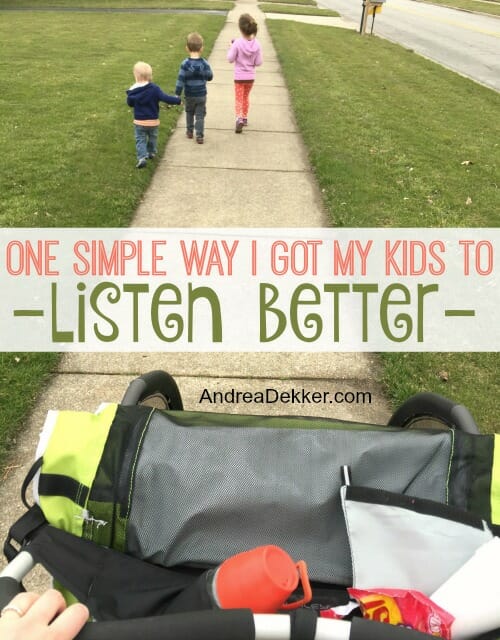
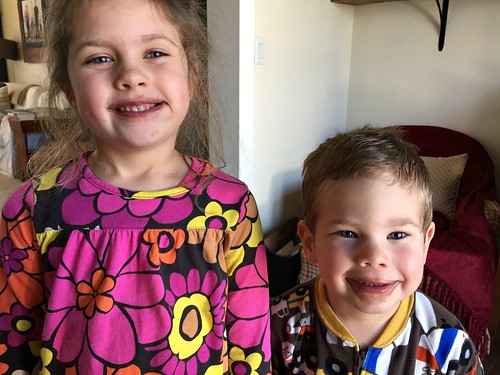
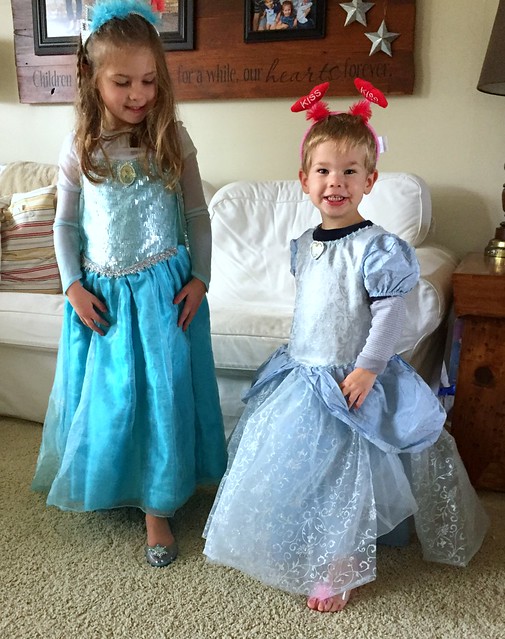
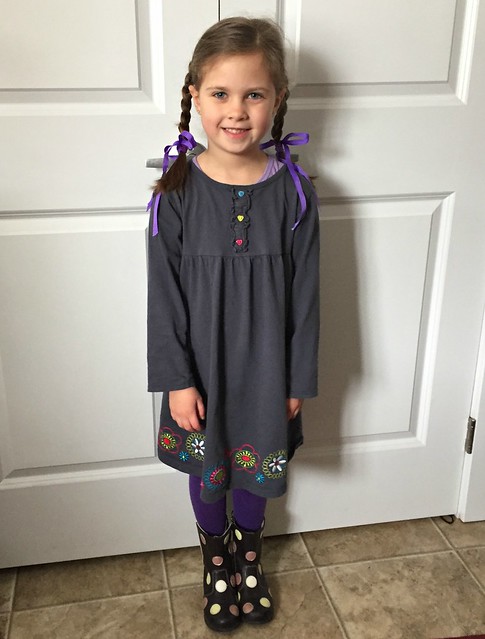
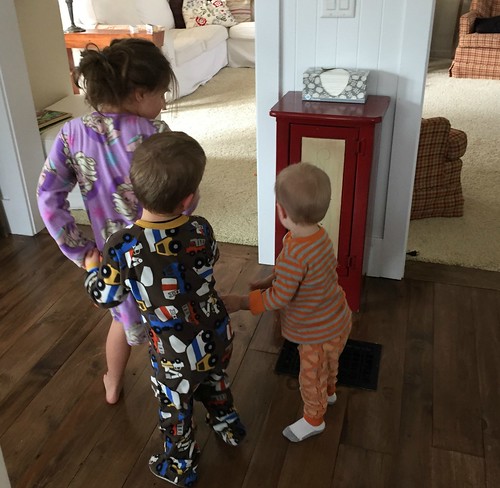
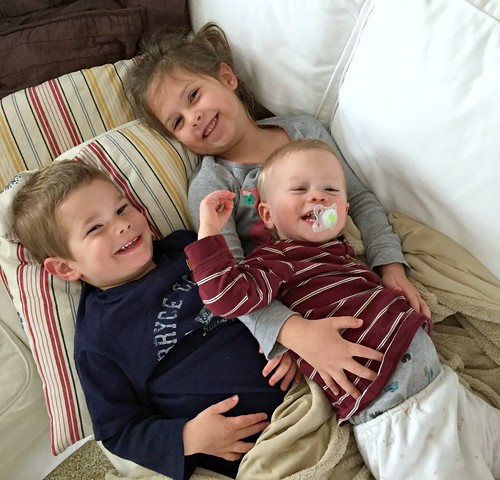
Sarah says
Oh my goodness! This has helped so much with my 4 year old boy. I started it as soon as I read this post and have been gobsmacked by it’s effectiveness! Hopefully our one year old boy will pick up on it in short order.
Thank you for sharing this simple and helpful tip!
Andrea says
yay — glad to help!!
Anna says
I find that I am doing the same thing but attribute the listen to having my kids stop and look at me to make sure they make eye contact and listen to what i am saying. But I do ask them if they understand and if they are still a little distracted I ask them to repeat what I said.
I also find that charts for routines like the morning and night time things they need to do also helps them do things on their own. They don’t get rewards or money for it they just put a check mark when completed. They are just there to let them know what needs to be done such as brush their teeth, get dressed and getting their back packs for the morning and evening includes bath time, story time, get clothes ready for the next day, brush teeth and get their backpacks put by the front door along with their shoes These definitely help but sometimes I do have to remind them but I find the older they get and the repeated activity everyday helps them when I’m not available to remind them or someone is helping me with them.
I also give them a 15 minute warning to change activities that way there is not a quick stop to their activity.
Andrea says
I wonder if charts would be more helpful once my kids are older?
And yes, I do the “15 minute warning” but my kids can’t tell time — so sometimes it’s 20 minutes, other times it’s 5 minutes. They don’t know the difference!
Diana says
Great reminder! My two toddlers do the same thing. And it makes me the same crazy. 🙂
I wonder if, by us taking the time to make them repeat, it makes us more engaged with them in that moment and that helps prompt the obedience too. Instead of just hollering “Get dressed now,” and expecting them to hop up and do it.
Another thing to add is this: if disobedience would result in consequences for a certain scenario, have them repeat the consequence back to you too. “I said to ________ or you will ________,” and have them fill in the blanks. That way if they choose to disobey, they also know they’re choosing the consequence.
Marisa says
Heh. I have the same problem with my 3 year old. Only he’s figured out that if he repeats it, he’ll have no way to deny knowing. So when I ask him to repeat what I said, the first time he’ll go mute; the second time he’ll act confused; the third time he’ll say it wrong on purpose; and the fourth time he’ll mumble, “I don’t want to say it.”
Yeah, it makes me crazy too!
Debbie says
Oh wow! What a simple but logical method! Even though I don’t have kids I love learning all the things you’re sharing. I’ve always loved taking care of kids, especially the age of your kids. Little bits of methods like this sure is helpful in understanding why they act the way they do and how to better manage the relationship with them.
Jennifer says
Thanks for the reminder about an effective strategy. It’s easy to get flustered and just keep repeating myself, but I know better. Several of the strategies mentioned in previous comments are helpful, too. Whispering is especially effective when we are in public because my son is more responsive when I tell him something privately. I also find a lot of success using a timer and getting my son to beat the clock. I also believe that if they know you’re always going to say things 3/4 times, and there are no consequences, they are never going to do anything the first time asked.
Paulette says
Great advice! The ‘Hershey’s Kiss’ photo? Hysterical!
Karyn Collett says
Great tip. If I am talking to the kids as a group like at the end of dinner, I say “attention” please”. They know that phrase means they must stop what they ate doing immediately, look and at me and listen.
Megan says
Thank you for this!
Kirsten says
I teach 4th grade and I use this tip with my students all the time, but haven’t thought to try it at home with my own kids! Great idea.
Kris says
Teenagers and toddlers are similar. I have started making my teen tell me what I have asked him to do because he nods and says ok says yeah yeah I did that and yet…that’s not what you asked. This post is reminding me that I am not crazy for doing this with him. My youngest has ADHD so the repeat thing is a must.
Andrea says
Teens, toddlers… and sometimes husbands too 🙂
Debbie says
Husbands…..how do you do that to the husband without sounding like you’re talking down to him?
Andrea says
haha — mine is more in a joking way — like if he’s watching a basketball game and I know he has no idea what I just said 🙂
Abbey says
That Hershey’s kiss picture is priceless!! Kids are so funny, I can totally see that happening in my house. Great tip, I’m going to have to try it with my girls!
Jen says
Oh my goodness, this makes me crazy! My son is the same age as Nora and this is a constant struggle. I even told him that this is what makes me angry and I really don’t like being angry. I’m definitely going to try this!
Andrea says
hope it works for you too!!
Kaye says
Here is a tip I learned as a teacher – only one direction at a time: “Pick up your books, please. (Done) Okay, thanks. Now pick up your shoes. (Done) Great job. Now come to the table. This works very well for small children or those with short attention spans. When they are little, they are actually learning to focus and these small bites of direction help them.
Andrea says
I know — but this takes so much extra time on my part 🙂 I have to stand over them the whole time, versus just listing off 3 things and then having them do the tasks all in a row.
Anna says
It really seems to help my kids when I get down on their level, so we are face to face, and tell them what I want them to do. I think it engages them more fully so they can really take in my instructions.
Andrea says
yes! Sometimes, when Simon is talking to me, he grabs my face and says “let me see your eyes mom!” It’s so cute 🙂
Kristin says
That’s a great tip! I think in this parenting journey any tip is worth trying and see if it works for your family! A tip I’ve just found out through trial and error with my older kids is pausing. When I ask them to do something, often they just need to get out their frustration at being interrupted and then once they do, they often happily do the request. I often too early jumped in and repeated myself. Now I pause! And as you said it’s not a iricale solution, but can be often effective.
Kristin says
Oh and another good one is – are your elephant ears listening to me – I remember this being a hit when my older two were younger!
Andrea says
good tip — I often repeat myself too quickly too. I might try this as well 🙂
Janet says
This is such a good tip! I need to use this for my husband and brother with ADD 🙂
Alicia says
Yep! I always have to do this with my kids. I also wait until they make eye contact , and (I have three boys) sometimes grab there hands so they’re facing me. Eye contact and even skin contact help little kids (especially boys!) focus!
Avia says
This is so timely for me and I am going to start trying that today! I actually keep meaning to find some articles about “helping” kids to listen because this is driving me bonkers! My girls still need help getting dressed and right now I’m trying to get them to stop running around in the middle of the getting dresses process. Shirt off – they run off and start playing – pants off – they throw themselves on the ground and start rolling around – shirt on….. you get the point. The only thing so far that has helped is to use the work “focus” and try to explain what that means and to keep reminding them – “when we are getting dressed I need you to focus.” Who would think these small things could be such a challenge!
Carol says
Another tip to use that I found helpful when my younger daughter was little–say her name before I say what I want to say. It got her attention and I repeated myself less. Might not work when dealing with three children, but it worked well with one! Great blog–enjoy it immensely!
Andrea says
haha — yeah, maybe not as effective with 3 kids (mainly because I often say the wrong person’s name!) Good tip though 🙂
Olga says
For my children i use 2 things to make them actually do what i ask them to do. First, whenever i want them to finish playing and do something, i give them heads up with time (15 min, 5 min, one min, then do whatever i said in the first place before time countdown right away). For me it just requires a little planning, and I’m fine with that.
Second thing that works best for us is giving 1-3 orders at a time, before the next set of orders. (Make bed, get dressed, straighten the bedroom before closing the door and heading to bathroom. Then, brush teeth, fix hair, check that everything is in its places before leaving the bathroom, etc.)
Especially in the morning they can’t remember long orders, and my children are fairy older than your Nora. 🙂
Diana says
This works so well for my son! If I set the timer, he almost always agreeably does what’s next. My daughter on the other hand, it doesn’t matter if I set a timer, warn her, tell her “this is going to be the last time,” she still throws fits every time a transition occurs. I can’t figure out what’s going on in her head that makes “THIS IS THE LAST TIME” not compute! If that was the last time, then NO you may not do it again and you knew it was coming! 🙂 Logic vs emotion-based brains, I think 🙂 She can even hear the timer ringing and wail “The timer didn’t riiiiiiiiiinnnnnng!” My nickname for her is “reality-denier” 🙂
Anna says
My son is the same way, I find my son needs more control or choices. So if he doesn’t get choices I try to find positive ways to let him feel in control to do what needs to be done and also try to help him communicate better.
But I find that letting him set the timer and turn off the time and it makes him feel more in control of the situation. I also work with him on trying to effectively communicate what he wants to say. So I give him 3 chances.
The first time he’s usually whining and argumentative and he gets a warning which aggravates him. The warning is no whining, you can say how you feel but you need to do it without whining and understand that you still have to do XXXX. Usually he does better the 2nd time and lately I haven’t had to use the 3rd time. Before he would whine for the first 2 rounds and then do better on the 3rd time. And when I started he would just whine the whole 3 rounds and end up in time out for whining.
I’ve gotten negative feedback on 3 chances being too many chances but I’d rather have an effective communicator.
Leannne says
yes!! working at the preschool, I use this technique a lot!…
2 choices…
1. the first choice is the negative consequence…
2. the second choice is much more tolerable and something the child will like
example:
“Michael, Mrs. Heern said to put the crayons down so we can clean up”…
when the child disobeys, I then say:
“Michael, since you did disobeyed Mrs. Heern’s instructions to put the crayons down, you will either need to put your head on the table while the rest of us listen to a story OR you can put the crayons down and come sit with us while we read”…. “what are you going to do?”…
I give them a few seconds… USUALLY, the child will take the second choice of the positive action versus the negative consequence…. but, if they choose the negative, I ALWAYS remind them that they CHOSE it by not doing what they were told…. 😉
Andrea says
great tips – thanks Leanne 🙂
Jen says
One thing I did when my kiddos were little and I wanted them to pay attention was WHISPER! It seems counter-intuitive–and most of us resort to raising our voices when we want someone to HEAR US ALREADY! But, in reality, I found that my kids wondered what I was saying and quieted down in order to listen. Of course, it’s not foolproof, and we had plenty of disobedience, but it worked for us!
My husband (a fifth grade teacher) has found that this works well in his classroom too!
Andrea says
ok this is awesome and I’m totally doing this. I have a feeling it will work really well too — they always want to know what Dave and I are talking about if/when we whisper!
Michelle Bonk says
I do this with my children and it really does work!!
(To be completely honest, I’ve even done it with my husband when I know he’s distracted when I’m asking him to do something! )
Andrea says
haha — me too (like when he’s in the middle of watching a basketball game!)
Heidi says
My phrase is always “Are you looking at my eyeballs?” and then wait until they make eye contact and THEN give them instructions. And one strategy I use in my classroom is to call a child by name, wait for the eye contact, and then tell them what I needed to.